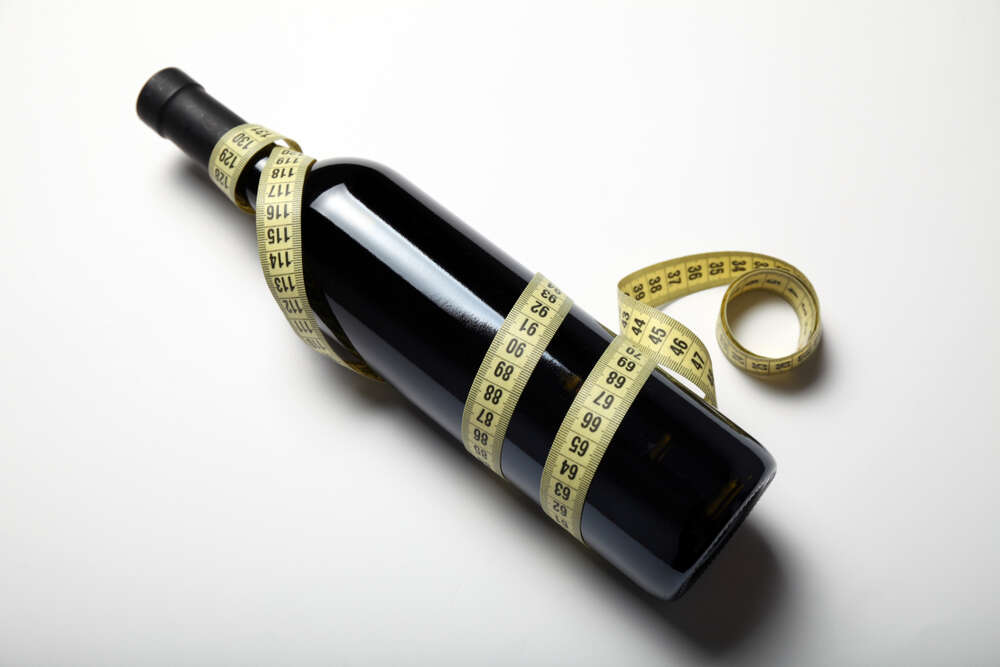
Myths abound about wine and weight. Dr Erik Skovenborg examines the medical data and literature to get a clearer picture.
The consumption of 1 ounce (30g) of alcohol per day, corresponding to about three units, contributes approximately 10 percent to total daily energy intake, given that the metabolizable energy density is 7.1kcal (28.8kJ) per gram. The addition of this amount of net energy to a weight-maintenance diet can be predicted to produce an increase in body weight of about 26lb (12kg) per year.1 In addition, an apéritif stimulates the appetite, and observational studies have supported the notion that moderate drinkers compensate insufficiently, or not at all, for the additional energy of alcohol in their food intake.
How can this be reconciled with data from experimental research such as a study where an extra 2,000kcal/day as chocolate for 14 days in one subject increased body weight by 6.1lb (2.78kg), whereas 2,000kcal/day as alcohol resulted in just +0.42lb (+0.19kg) after 30 days?2 In another study, the addition of 630 alcohol calories/day for 30 days to the baseline diet did not cause weight gain in the lean individuals, even though the extra calories should have produced an increment of 5.27lb (2.39kg).3 A meta-analysis of 127 observational studies found a U-shaped association between alcohol intake and odds of obesity such that moderate alcohol drinkers had lower odds of obesity compared to non-, light, and heavy alcohol drinkers.4
Mystery of the missing calories
Since obesity is a condition affected by numerous factors, including lifestyle habits, environment, and genetics, accurately determining the independent effect of alcohol consumption on weight is difficult. The jury is still out on the conflicting evidence on wine and weight, but let’s take a look at some factors that may contribute to an explanation of the missing calories.
Wine drinking: Wine, beer, and spirits differ with regard to concentrations of specific biologically active substances, which might influence energy balance. An analysis of the association between types of alcoholic drinks and adiposity in the UK Biobank study showed that red wine, Champagne, white wine, and fortified wine drinkers had a lower BMI (body mass index)compared to never drinkers of each type of alcoholic drink, whereas beer and spirits drinkers had a higher BMI compared to never drinkers. The study did not find a link between overall alcohol consumption and higher risk of obesity.5
Drinking pattern: For a given level of total alcohol intake, obesity was inversely associated with drinking frequency in the Danish Diet, Cancer and Health study, whereas the amount of alcohol intake was positively associated with obesity. The inverse association between drinking frequency and large BMI was generally stable for different levels of total alcohol intake. The results indicate that frequent drinking of small amounts of alcohol is the optimal drinking pattern.6
NEAT: Humans show considerable inter-individual variation in susceptibility to weight gain in response to overeating. The activation of NEAT, or non-exercise activity thermogenesis (standing, talking, walking, fidgeting, and so on), dissipates excess energy to preserve leanness.7 An effect of alcohol on NEAT could be a possible explanation for the seemingly missing effect of alcohol calories found in many studies. The theory that alcohol may activate NEAT differently from other foods is supported by the results of a study by Raben et al. A higher thermogenic response was observed after a meal rich in alcohol (27 percent) than after meals rich in protein, fat, or carbohydrate (17 percent) with similar energy densities and dietary fiber contents.8
BMI: To assess whether energy from alcohol is efficiently utilized to maintain body mass, Clevidence et al examined changes in energy intake of young women when they drank 30g of alcohol per day and found a divergence in response between lean and heavy subjects. Fifteen women required, on average, an additional 886 ± 147kJ/d to maintain body weight during the alcohol treatment, and these women were leaner (with a BMI of 22.6kg/m2) than the 22 women who required, on average, 559 fewer kJ/d when on the alcohol treatment (BMI 25.2kg/m2).9
NOTES
1. B Buemann, A Astrup, “How Does the Body Deal with Energy from Alcohol?” Nutrition 17 (2001), pp.638–41.
2. RC Pirola, CS Lieber, “The Energy Cost of the Metabolism of Drugs, Including Ethanol,” Pharmacology 7 (1972), pp.185–96.
3. JR Crouse, SM Grundy, “Effects of Alcohol Plasma Lipoproteins and Cholesterol and Triglyceride Metabolism in Man,” Journal of Lipid Research 25 (1984), pp.486–96.
4. M Golzarand, A Salari-Moghaddam, P Mirmiran, “Association between Alcohol Intake and Overweight and Obesity: A Systematic Review and Dose-Response Meta-Analysis of 127 Observational Studies,” Critical Reviews in Food Science and Nutrition 62 (2022), pp.8078–98.
5. E Inan-Eroglu, L Powell, M Hamer, et al, “Is there a Link between Different Types of Alcoholic Drinks and Obesity? An Analysis of 280,183 UK Biobank Participants,” International Journal of Environmental Research and Public Health 17 (2020), 5178.
6. JS Tolstrup, BL Heitmann, AM Tjønneland, et al, “The Relation between Drinking Pattern and Body Mass Index and Waist and Hip Circumference,” The International Journal of Obesity 29 (2005), pp.490–97.
7. JA Levine, NL Eberhardt, MD Jensen, “Role of Non-Exercise Activity Thermogenesis in Resistance to Fat Gain in Humans,” Science 283 (1999), pp.212–14.
8. A Raben, L Agerholm-Larsen, A Flint, et al, “Meals with Similar Energy Densities but Rich in Protein, Fat, Carbohydrate, or Alcohol Have Different Effects on Energy Expenditure and Substrate Metabolism but not on Appetite and Energy Intake,” The American Journal of Clinical Nutrition 77 (2003), pp.91–100.
9. BA Clevidence, PR Taylor, WS Campbell, et al, “Lean and Heavy Women May not Use Energy from Alcohol with Equal Efficiency,” The Journal of Nutrition 125 (1995), pp.2536–40.






